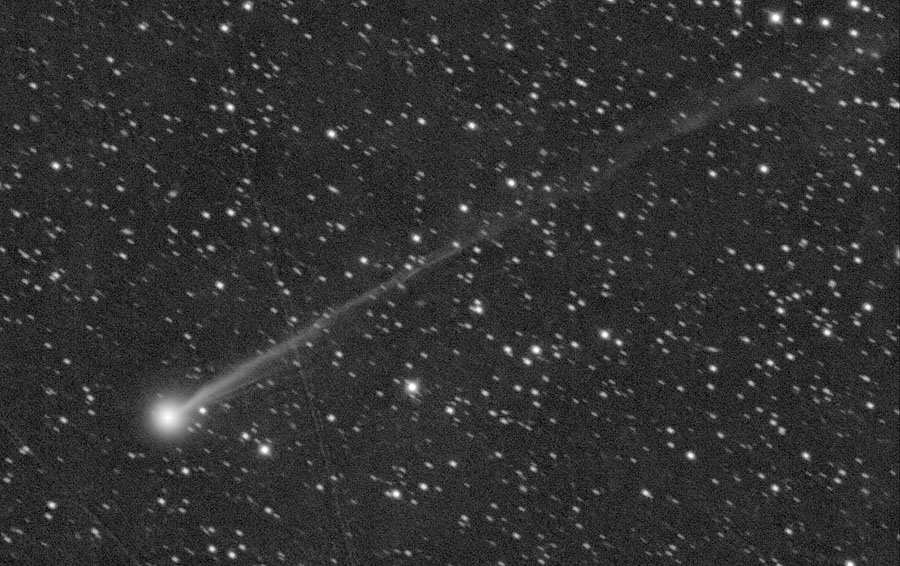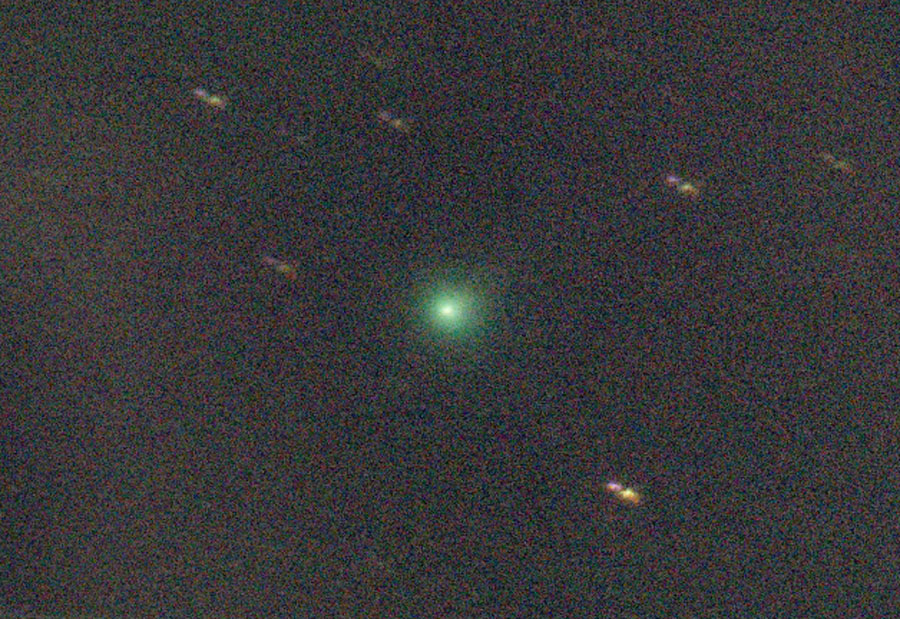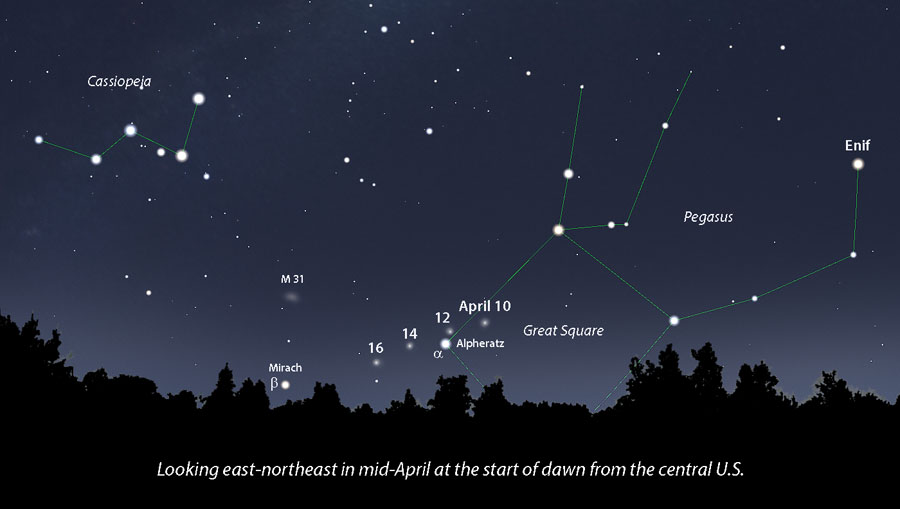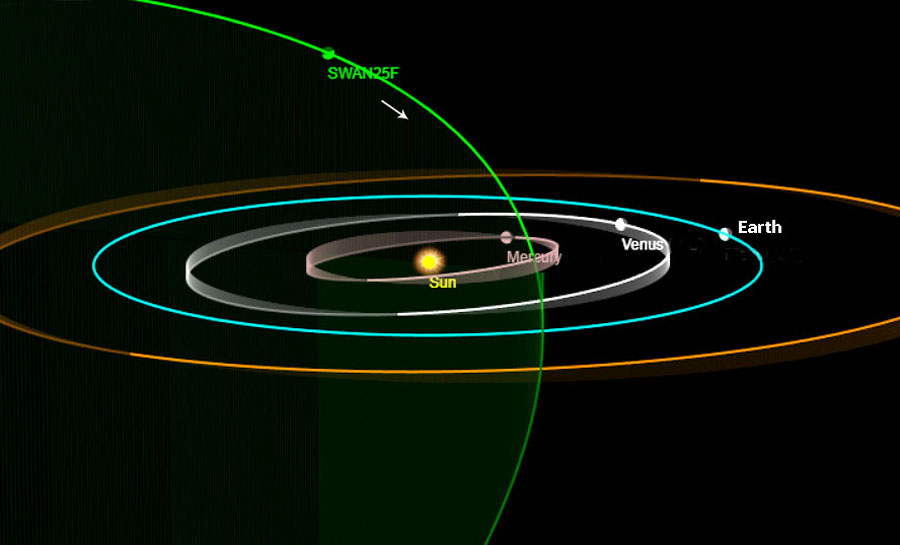From :- Sky & Telescope
By :- Bob King
Edited by :- Amal Udawatta

Michael Jaeger
Amateur astronomers have done it again — discovered a comet. Not by looking through a telescope but through close study of publicly released, low-resolution images taken by the Solar Wind Anisotropies (SWAN) camera on the orbiting Solar and Heliospheric Observatory (SOHO).
On March 29th, Vladimir Bezugly of Ukraine was the first to report a moving object in SWAN photos taken the week prior. Michael Mattiazzo of Victoria, Australia, independently found "a pretty obvious comet" the same day using the same images, noting that the object was about 11th magnitude and appeared to be brightening. Rob Matson of California had also been examining the SWAN data and reported his independent discovery on March 31st. On April 1st, discovery details and early positional measurements were posted on the Comets Mailing List discussion group.
Comet Swan it is
Thanks to the discoverers' efforts to spread the word, the amateur community quickly geared up and observations of the comet began pouring in. Temporarily designated SWAN25F, the new visitor received its official name C/2025 F2 (SWAN) on April 8th. According to naming guidelines, comets discovered using public data or images are named for their program of origin, not the individuals who make the discovery.
At the time C/2025 F2 was moving northeast across the Great Square of Pegasus and visible low in the eastern sky at the start of dawn. Despite the early hour, observers were pumped to see it. Pickings have been slim since the heady days of Tsuchinshan-ATLAS (C/2023 A3) and ATLAS (C/2024 G3). All new comets with bright prospects are welcome!

MegaStar, courtesy of Emil Bonanno, with additions by Bob King
The first ground observations of Comet SWAN pegged its magnitude at around 9.5 — bright enough to punch through atmospheric extinction and make it a fairly easy target in smaller telescopes despite its low altitude (~10° ) at the start of dawn. Over the next month, during the best part of its apparition, the comet will continue to hover low in the sky and tussle with twilight. Fortunately, it's also expected to brighten by at least several magnitudes.
Given Comet SWAN's high northerly declination, observers in mid-northern latitudes are favored. For now the comet's clicking northeast across the Great Square at some 1.75° per day. In the next two weeks, it will leave Pegasus for Andromeda, then sail through Triangulum. Perihelion occurs on May 1st, when the fearless flyer will coast 49 million kilometers (31 million miles) from the Sun while passing about 2° north of the Pleiades cluster.

Gianluca Masi
I got my first look on April 4th just before 5 a.m. local time at the start of twilight. Through my 15-inch (38 cm) Dob at 64× it was immediately obvious, glowing at magnitude of 9.5 with a well-condensed 3′ coma. No tail was seen. Observers got a pleasant surprise on April 6th, when SWAN's magnitude shot up to 8.1. That morning I waited for narrow slivers of clear sky between clouds to see its transformation into a bright, strongly-condensed fuzzball. The 15-inch was overkill. A 6-inch would have nailed it. I even detected a hint of blue-green coloration from fluorescing diatomic carbon in the coma.

Juanjo Gonzalez
The comet either experienced a temporary outburst or it could have been an indication of a steep brightening trend. Seiichi Yoshida, who maintains Weekly Information About Bright Comets, predicted that SWAN would peak around 5th magnitude at perihelion. But the latest ephemeris published April 8th by the Central Bureau for Astronomical Telegrams (CBAT) forecasts a more optimistic magnitude 3.6 — with a caveat. Due to our incomplete understanding of the nature of the comet's outburst, Daniel Green, CBAT director, cautioned that "predicting the comet's brightness as it approaches perihelion is necessarily highly uncertain."
How and when to view the comet
If you plan to observe the comet you'll need a location with an unobstructed view to the northeast. It will be a morning sky object until about April 25th. Currently, it stands about 10° to 12° high at the start of dawn. But its altitude slowly declines in the next two weeks. The good news is that our visitor is bright enough to observe in early morning twilight, when it's up higher and less affected by the atmosphere. Dawn begins about 1 hour 50 minutes before sunrise in the northern U.S. and 1 hour 30 minutes for the southern half of the country at this time of year.

Stellarium with additions by Bob King
In late April, it moves into the evening sky and should be significantly brighter (if predictions hold), but it will also compete with lengthening twilight and low altitude. During the morning-evening transition, it may be visible at both dawn and dusk VERY low in the northeast and northwest, respectively, in mid-twilight.
From latitude 40° north, the comet stands about 5° high an hour after sunset on April 24th and 8° on May 1st, when it hangs just above the Pleiades cluster. Thereafter it drops deeper into twilight and will be lost to view after about May 8th. Southern Hemispheres skywatchers will get their chance join the party around May 4th. Their patience will be rewarded by extended views of the comet for the remainder of May and beyond.

Courtesy of Tony Dunn
You can use the maps provided here to follow Comet SWAN or download orbital elements for a variety of software programs at the Minor Planet Center's Orbital Elements for Software Packages. Click on your software link, save the element file, and drop it into your program. I checked, and the latest update includes C/2025 F2. Some applications like Stellarium have to be updated by opening the program, clicking through options and then downloading the latest file into the program. If you prefer to hand-plot positions on a map, head over to Bill Gray's "Pseudo MPEC" for SWAN25F, where he posts daily hourly ephemerides.
I'll provide updates and new finder charts in the coming weeks. For now, let's get out there and greet this dusty traveler.
Comments
Post a Comment